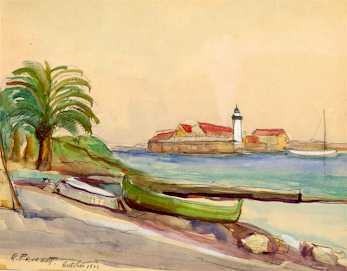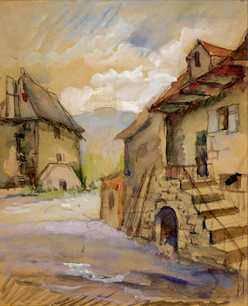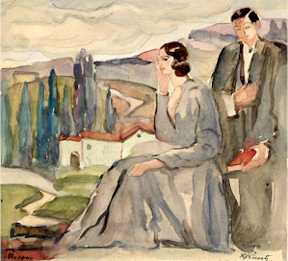|
 Those
war days broke up this happy existence. Having to leave everything overnight,
Raphael Pricert first takes refuge in the South of France, where he was
later joined by his wife and daughter, Liliane, born in May 1942. He
continues to travel around on the Côte d’Azur in search of landscapes and
characters, and paints portraits. Those
war days broke up this happy existence. Having to leave everything overnight,
Raphael Pricert first takes refuge in the South of France, where he was
later joined by his wife and daughter, Liliane, born in May 1942. He
continues to travel around on the Côte d’Azur in search of landscapes and
characters, and paints portraits.
1943 :
Having escaped the Gestapo by miracle, he manages to find paints and
canvases to continue his drawing and painting, travelling around the region,
painting numerous landscapes, modest homes and portraits of humble and
picturesque people.
1944-1946 :
shortly after the Liberation, he exhibits his paintings in Vixouze,
Polminhac, Vic-sur-Cère and Aurillac – sponsored by the National
Intellectual Committee. Inspite of the difficulties and shortages of those
times, he gains a reputation in this beautiful region of France. Well-to-do
and even more modest people want to buy his works.
From
September 21st to October 5, 1946 the Gallery Giraudo on Avenue
de l’Opera in Paris puts on an exhibition of his Auvergne paintings. This
exhibition was a success and it was warmly praised in the art press.
He
reappears in the Salon des Tuileries in 1946 with two of his Auvergne
paintings : the ‘Auvergne tramp’
and the ‘Old Salers’, and he
later exhibits several canvases and watercolors at the Hotel de Bordeaux in
Aurillac from December 17 to December 30, 1946.
This
latter exhibition proves very successful, very warmly prefaced by Raymond
Cortat, a leading personality in the Cantal region.
As
a result of this tremendous success, Raphael Pricert decides to dedicate
himself full-time to his artistic creation, and stops his work for Mr.
Faivret’s advertising agency.
At
this time, he must rebuild everything in his life. He discovers that his
appartment on Rue Besnard is occupied by a war-widow. All his paintings have
disappeared. He is told that the German soldiers had to get the paintings
out of the window as they were so large that they did not fit in the lift
before being taken away by lorry !
Given
the situation, his landlord offers him an artist studio on the outskirts of
Paris in Issy les Moulineaux. This is a large apartment on the 8th
and 9th floor of a 1936 building, previously occupied by the
Milicia, this penthouse is
painted in red and still displays the pictures of Hitler and Mussolini. Once
cleaned out, this flat became his working studio.
 He
did not find out what happened to his many paintings which had disappeared.
However two years later, it was one of them which caused him to find again
one of his cousins who had settled down in New York some 30 years ago, and
this is how he exhibited for the first time in the USA. He
did not find out what happened to his many paintings which had disappeared.
However two years later, it was one of them which caused him to find again
one of his cousins who had settled down in New York some 30 years ago, and
this is how he exhibited for the first time in the USA.
In
May 1947, Raphael Pricert and his wife acquire French nationality. He
returns to the Auvergne and exhibits his Auvergne works at the Galerie
de la Cité in May 1947, at the Chamber of Commerce of Aurillac in
February 1949, at the third Salon des
Beaux Arts et lettres of the
Massif Central region, and on the Faubourg Saint Honoré in Paris from
February 25 to March 15, 1950.
From
1947 he is insearch of new inspiration : in Belgium at a joint
exhibition, in the summer on the Côte d’Azur and in Corsica, in Italy, in
Venice, Florence and Rome to which he returned frequently as of 1948, and of
course always Paris.
From
end 1947 to January 3, 1948, he puts on a exhibition in Paris, rue La Boetie
at the Gallery Cambaceres, where he shows his paintings of Bruges and
Corsica.
In
1948, his cousin Irving, long lost since the First World War, and who since
then settled in New York, comes to hear about him. An American journalist
contacted him to find out if he knew of a certain Raphael Pricert, the
painter of a painting he purchased in Berlin, and at the back of which was
the address of rue Besnard in Paris. Irving came over to Paris to find his
cousin, and this is how he was introduced to a Gallery in New York « the
Associated
American Artists ».
 Previous
period
Next period Previous
period
Next period
|